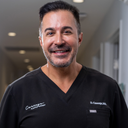It would be helpful in regards to making an assessment if you didn’t have the red wrap on your chest. Regardless, it looks like you have full developed bilateral gynecomastia and this should be treated. There are generally three components, plastic surgeons look at when making an assessment. Understanding how much each of the three components is contributing helps decide what surgical approach will be best and what type of results the patient can expect. The three variables are excessive glandular breast, tissue or true gynecomastia, excess subcutaneous fat, and lastly, skin laxity. even if the skin doesn’t appear loose the development of breast tissue may have stretched out the skin envelope leaving you with a skin lack of the issue that can compromise the results if the skin is not addressed. Removing the majority of breast tissue and doing a breast lift at the same time is tricky and the approach is very different than female surgery. if you’re interested in having this treated, then I suggest scheduling multiple in person consultation with plastic surgeons in your community. Who seem to have a lot of experience doing guided Kasta surgery. This type of work is not always straightforward or easy so be careful when choosing providers. During each consultation, I suggest you ask each provider to open up their portfolio and show you as many before, and after pictures as possible of previous patients who had similar chest characteristics to your own. and experience plastic surgeon should have no difficulty showing you before and after pictures of at least 50 previous patients. Being shown a handful of pre-selected images, representing only the best results of a providers career or of patients whose characteristics are very different than your own does not give you sufficient information , regarding that providers competence experience, what results are likely to look like. Being board-certified in plastic surgery does not mean a surgeon has mastered every procedure and there is going to be significant differences in outcomes, depending on how you choose your provider.







